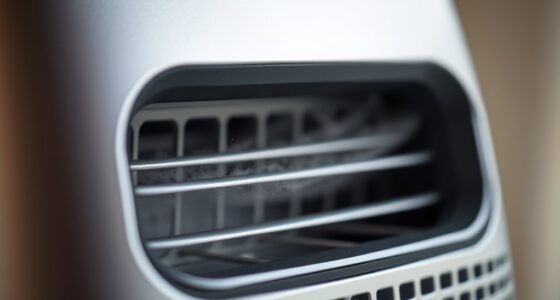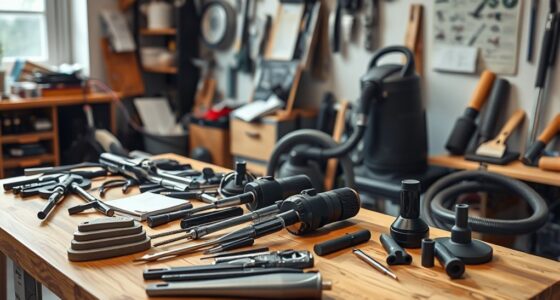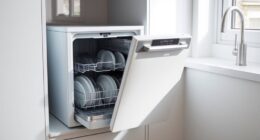To maintain your upright vacuum, regularly check the belt for signs of wear like cracks or stretching and replace it if needed, ensuring it’s taut but not overstretched. Clean hair, threads, and debris from the brush roll to keep it spinning freely and maximize agitation. Also, clear any blockages from the hose and replace filters as recommended. Keeping all these components in top shape boosts performance and extends your vacuum’s lifespan—more helpful tips await if you keep going.
Key Takeaways
- Regularly inspect and replace the belt to ensure proper tension and avoid motor strain.
- Clean the brush roll of hair, string, and debris to maintain effective carpet agitation.
- Check and clear hose blockages to restore optimal airflow and suction power.
- Clean or replace filters periodically to prevent airflow restrictions and dirt buildup.
- Follow manufacturer guidelines for all maintenance tasks to prolong vacuum lifespan and performance.

Regular maintenance is essential to keep your upright vacuum performing at its best and extending its lifespan. One of the most important tasks involves inspecting and replacing the belt when it shows signs of wear. Over time, the belt can become stretched, cracked, or broken, which reduces suction power and hampers the brush roller’s ability to pick up dirt effectively. To replace the belt, unplug the vacuum and carefully remove the brush roll cover. Slide out the old belt, noting how it’s positioned, then install the new belt by looping it around the motor shaft and the brush roller. Make sure it’s taut but not overstretched. Proper belt replacement ensures that your vacuum maintains peak performance and prevents unnecessary strain on the motor.
Alongside belt replacement, brush roller cleaning is crucial for keeping your vacuum working efficiently. Hair, string, and debris tend to wrap around the brush roll, choking off airflow and diminishing cleaning power. Regularly turn off and unplug your vacuum, then remove the brush roll. Use scissors or a seam ripper to cut away tangled hair and threads, and wipe the roller with a damp cloth to remove dust and dirt. This prevents the buildup from impacting the roller’s rotation and helps maintain effective agitation of carpet fibers. Ensuring the brush roller spins freely also reduces strain on the motor and prolongs the life of your vacuum.
Don’t forget about the hose and filters, as clogs and dirt buildup here can drastically reduce suction. Check the hose periodically for blockages, and clear any obstructions with a long brush or broom handle. Clean or replace filters according to the manufacturer’s instructions, as clogged filters restrict airflow and decrease cleaning efficiency. Maintaining a clean hose and filters complements belt replacement and brush roller cleaning, creating a thorough approach to vacuum upkeep. Additionally, maintaining familiarity with the vacuum’s components can help you identify issues early and ensure all parts work harmoniously for optimal performance.
Frequently Asked Questions
How Often Should I Replace the Vacuum Belt?
You should replace the vacuum belt every 6 to 12 months to guarantee ideal belt replacement and vacuum longevity. Regularly check for signs like a squealing sound, reduced power, or difficulty spinning the brush roll. Promptly changing the belt prevents strain on your vacuum’s motor and keeps cleaning performance at its best. Proper belt care extends your vacuum’s lifespan, saving you money and hassle in the long run.
Can I Repair a Broken Vacuum Brush Myself?
Yes, you can repair a broken vacuum brush yourself with some repair tips. First, unplug your vacuum for safety. Remove the brush from the brush roll assembly, then check for tangled hair or debris that might cause issues. If the brush bristles are damaged, consider replacing the brush or trimming frayed bristles. Use a screwdriver and follow your vacuum’s manual to guarantee proper reassembly, saving you time and money.
What Signs Indicate a Hose Needs Replacing?
If your hose shows signs of cracking, holes, or persistent clogs that won’t clear, it’s time to replace it. Check the hose material—plastic or rubber—that may weaken over time. Typically, hoses need replacement every few years, depending on usage. If you notice reduced suction or leaks, it’s a clear sign that your hose has reached the end of its lifespan and should be swapped out for a new one.
How Do I Prevent Belt Slippage?
To prevent belt slippage, guarantee the belt tension is correct—neither too tight nor too loose. Check the drive mechanism regularly for obstructions or wear, as these can affect belt performance. Keep the belt aligned properly and replace it if it shows signs of wear or damage. Proper maintenance of these parts keeps your vacuum running smoothly, avoiding slippage and extending its lifespan.
Are There Eco-Friendly Options for Vacuum Maintenance?
Yes, there are eco-friendly options for vacuum maintenance that support sustainable cleaning. You can choose vacuums with recyclable parts or those made from eco-conscious materials. Regularly cleaning and replacing belts, brushes, and hoses with sustainable alternatives reduces waste and prolongs your vacuum’s life. Using eco-friendly cleaning solutions for your vacuum’s components also helps minimize environmental impact. This approach guarantees your cleaning routine is both effective and environmentally responsible.
Conclusion
Keeping your upright vacuum in top shape is simple when you regularly check the belt, brush, and hose. Did you know that neglecting these parts can reduce your vacuum’s efficiency by up to 50%? By taking just a few minutes to maintain them, you’ll extend your vacuum’s lifespan and make cleaning easier. Stay proactive with your maintenance, and enjoy a cleaner home with less effort and more power!









